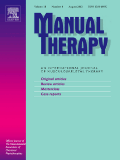
PHYSICAL THERAPY & REHAB
Effect of osteopathic manual treatment on biomechanical dysfunction in patients with LBP
Man Ther. 2014 Aug;19(4):324-30230 patients, between the ages of 21 and 69, who had been experiencing persistent/chronic low back pain for 3 months, were randomly assigned into 1 of 2 groups (in the OSTEOPATHIC Trial) to determine the effect osteopathic manual treatment (OMT) and ultrasound had on chronic low back pain. Patients took part in a treatment regimen either consisting of OMT and active ultrasound, or OMT and sham ultrasound. Results from the OSTEOPATHIC Trial suggested that ultrasound had no significant effect on low back pain outcomes, and so, a secondary analysis was completed to determine the effect OMT had on biomechanical dysfunction. Results from this secondary analysis indicated that OMT led to significant improvements in each biomechanical dysfunction category (Non-neutral lumbar dysfunction, pubic shear, innominate shear, restricted sacral nutation, psoas syndrome) and that remission of psoas syndrome was the only change in biomechanical dysfunction that significantly predicted subsequent low back pain response.
Unlock the full ACE Report
You have access to {0} free articles per month.Click below to unlock and view this {1}
Unlock NowCritical appraisals of the latest, high-impact randomized controlled trials and systematic reviews in orthopaedics
Access to OrthoEvidence podcast content, including collaborations with the Journal of Bone and Joint Surgery, interviews with internationally recognized surgeons, and roundtable discussions on orthopaedic news and topics
Subscription to The Pulse, a twice-weekly evidence-based newsletter designed to help you make better clinical decisions
Exclusive access to original content articles, including in-house systematic reviews, and articles on health research methods and hot orthopaedic topics
Or upgrade today and gain access to all OrthoEvidence content for just $1.99 per week.
Already have an account? Log in


Subscribe to "The Pulse"
Evidence-Based Orthopaedics direct to your inbox.
{0} of {1} free articles
Become an OrthoEvidence Premium Member. Expand your perspective with high-quality evidence.
Upgrade Now












































































